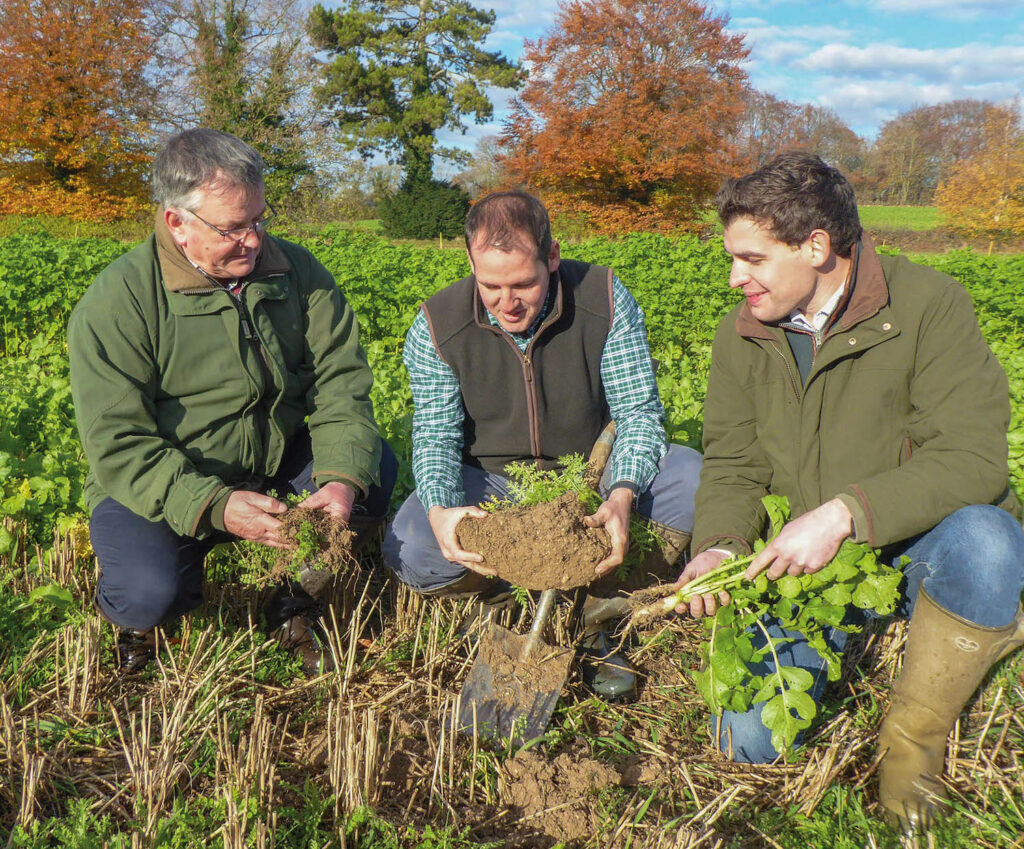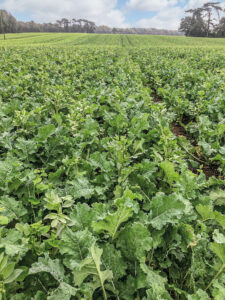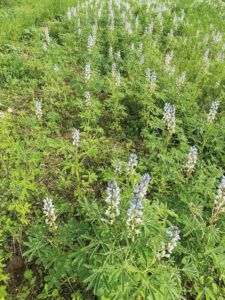Better farming ‘delivers net zero’ in South Wales
1st April 2022
Net zero has never been a primary goal for Richard and Lynn Anthony and their team at Tythegston Farm, near Bridgend, on the South Wales coast. But the latest Farm Carbon Toolkit calculations show the 1,200ha they own and manage are annually sequestering over 21,000t CO2eq.

Richard Anthony, Chris Taylor and Dan Moore checking on a cover crop.
More than anything else, such a positive contribution to carbon capture results from the progressive farming improvements made over the past 10 years in particular, with the accent firmly on soil health.
“It’s really not complicated,” insists Mr Anthony. “You need to grow something to take in CO2. Then you have to hold it in your soil. Essentially, this means two things – keeping as much green cover as possible throughout the year, and doing everything you can to build and maintain soil organic matter. At the end of the day, it all comes down to soil health. Which is, after all, the key to our overall resilience and financial sustainability too.”
This philosophy has resulted in a six-year rotation involving nine separate crops on ground that can grow maize, and a five-year rotation with six separate crops on particularly heavy, wet land.
Winter wheat is central to both rotations, with upwards of 450ha being grown alongside around 300ha of maize, 200ha of OSR and 250ha of grass. Good local markets and the need for resilience means all the wheat is grown for feed, with a five-year average of just over 10t/ha.
On more favourable ground, wheat is followed by a mixture of winter rye and Westerwolds ryegrass grazed by sheep then cut for silage ahead of maize planting in April. This sequence is repeated, followed by another crop of wheat, winter OSR and a catch crop of phacelia before going back to wheat.
Where maize can’t be grown, the wheat/winter OSR/phacelia/wheat recipe is followed by two years of Italian ryegrass for silage then back to wheat.
“As an Agrii iFarm, we have had the advantage of being able to test out a wide range of catch and cover crops, companions for our OSR, and different cropping and soil management opportunities; not to mention exploring the best wheats for our high septoria environment,” explains Mr Anthony.

OSR with companion crops.
Go-to catch crop
“Phacelia has been our go-to catch crop for a while now. Its brilliant rooting works wonders for the soil and worms. Having trialled a whole host of other species with Agrii, we’ll be adding vetches to it next year.”
“We’ve really stepped-up our OSR companion cropping in the past four years – mainly to find the best way of maintaining mycorrhizae and building other elements of soil health through the rotation,” adds farm manager, Dan Moore.
“We’re not there yet, but our current combination of spring beans, buckwheat and purple vetch is looking good. Especially now we’ve adapted a second-hand Mzuri drill to sow all the species at the right depths.
“The companions have certainly helped limit flea beetle problems, but their real beauty is in the way they work together to support the rape. The beans and the vetch do a great job in rooting and nitrogen capture, while the buckwheat mines phosphate. With their support, all our OSR averaged around 5t/ha last year.”
Quietly reducing tillage
The Tythegson team have been quietly reducing tillage for a good 15 years now, and would like to do so even further. Soils ranging from pure sand to heavy wet clays with silt contents of up to 70% plus 1,250mm of annual rainfall, however, limit their no-till opportunities.
The OSR apart, Vaderstad Rapid drilling following a shallow pass with a Topdown (fitted with 50mm points for good soil loosening with the least mixing) is currently the standard practice. Sowing the phacelia with the Topdown, however, allows the following wheat to be drilled directly. And a 12-year-old Horsch Sprinter that has seen a lot of work provides a valuable wet weather drilling option.
With such a strong local demand, all the cereal straw is baled. This means the business has had to rely on local authority compost and turkey litter, together with cover cropping in building soil organic matters from around 2–3% to the impressive 7–8% of most of their ground now. The Farm Carbon Toolkit underlines the overwhelming contribution this makes to their negative carbon footprint.

Lupins on trial.
All but eliminate artificial fertilisation
Valuable here too is the contract they have to manage digestate from a major carbon neutral domestic waste AD plant right on their doorstep. It has involved a lot of investment in umbilical systems and 19,500-litre tankers with 24m dribble bar booms (justified by the substantial contracting business managed by their son, David) but this has allowed the Anthonys to all but eliminate artificial fertilisation.
This and the team’s desire to keep on improving soil health, and with it their carbon footprint, is leading a number of further companion cropping, rotational and agronomic improvements to be explored with their Agrii agronomist, Chris Taylor.
Foremost amongst these are introducing white clover into the two-year IRG leys and maintaining it under the wheat and right through to the OSR, and growing a cash crop of lupins for local feed markets as a spring-sown alternative to maize.
“We’ve had two years of very positive field-scale trials with lupins so far,” Mr Taylor says. “Even though they weren’t sown until June and harvested in early October, they averaged 3.5t/ha last season with no fertiliser or crop protection inputs whatsoever. Add in nitrogen fixing, and they’re a very exciting opportunity here. We’re scaling-up lupin growing this coming spring, but don’t want to get too carried away until we’ve fully explored the implications for the rotation.”
With a local history of brome and resistant ryegrass problems, cutting back on herbicides is a major challenge. However, using the most competitive wheats, not drilling them too early, keeping year-round cover and having maize as a spring break are proving very valuable here. As are two years of silaging everything well before heading in the heavy land rotation.
“For us, it’s all a matter of farming better,” Mr Anthony explains. “We do this by looking hard at the issues we face and the opportunities we have; by never being afraid to try new things; and by making the most of those that work. And with better farming comes better sustainability in every way.”
